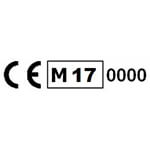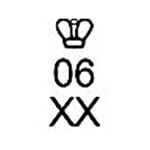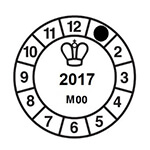Measuring alcoholic drinks in restaurants
The entrepreneur is responsible for ensuring that only appropriately verified measuring instruments compliant with the Measuring Instruments Act are used in measuring the amount of alcoholic drinks.
The entrepreneur is responsible for ensuring that only appropriately verified measuring instruments compliant with the Measuring Instruments Act are used in measuring the amount of alcoholic drinks.
Capacity serving measures used to measure alcoholic drinks (transfer measures, also known as jiggers, such as 12cl, 8cl, 4cl, 2cl, 1.5cl or 1cl) must fulfil the requirements of the Measuring Instruments Act. In-service verification of the capacity serving measures is not necessary, if the verification mark is readable and the measure is intact.
New capacity serving measures to be commissioned must comply with the requirements of the Measuring Instruments Directive; in that case, they will have a CE marking as shown in Figure 1.

Figure 1. Marking indicating conformity with MID
Old transfer measures may have the national verification mark shown in Figure 2. Old transfer measures may be used, if the measure is intact and its markings are readable.

Figure 2. National inspection mark of an alcoholic spirits measure.
Meters for alcoholic beverages (meters for spirits, wine, beer, cider and long drinks) must be verified
Approved line measures for alcoholic beverages (lined glasses, standard size glasses) are an alternative to transfer measures and meters for alcoholic beverages.
Approvals of line measures issued in accordance with the Measuring Instruments Directive (MID) may apply to all serving sizes and types of alcoholic beverages. Lined glasses compliant with the Measuring Instruments Directive have the marking shown in Figure 1.
When using approved line measures for alcoholic beverages, always measure the beverage to the line.
In-service verification of transfer measures and line measures is not necessary, if the measure is intact and its markings are readable.
An in-service verification must be performed on verifiable beer and cider taps, optic (non-drip) measures and meters for alcoholic spirits every 3 years.
The inspections are carried out by inspection bodies approved by Tukes.
The inspections of measuring instruments for serving alcoholic beverages are shown in the following table.
A verified measuring instrument has the marking shown in Figure 3, indicating the time when the verification was performed.

Figure 3. Mark indicating a completed verification. In this example, the verification was performed in January 2017.
Table 1. Measuring instruments for serving alcoholic beverages and their respective requirements
| Timing | Before commissioning | After commissioning | ||
|---|---|---|---|---|
| National requirement | MID | |||
| Measuring instruments | Type examination | Initial verification | Declaration of conformity | In-service verification |
| Optic (non-drip) measures | - | x | _¹ | x |
| Meters for beer/cider | x | x | _¹ | x |
Meters for alcoholic spirits
|
x | x | _¹ | x |
Transfer measures (for spirits and wine)
|
- | - | x | - |
Line measures for
|
- | - | x | - |
1 These measuring instruments are not covered by the Measuring Instruments Directive (MID), and national type approval and verification requirements still apply.